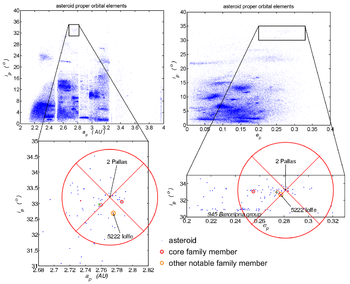Pallas family
The Pallas family (adj. Palladian; FIN: 801) is a small asteroid family of B-type asteroids at very high inclinations in the intermediate asteroid belt.[1][2] The family was identified by Kiyotsugu Hirayama in 1928.
The namesake of the family is 2 Pallas, an extremely large asteroid with a mean diameter of about 512 km.[3] The remaining Palladian asteroids are far smaller; the largest is 5222 Ioffe with an estimated diameter of 22 km. This, along with the preponderance of the otherwise rare B spectral type among its members, indicates that this is likely a cratering family composed of ejecta from impacts on Pallas.
Another suspected Palladian is 3200 Phaethon, the parent body of the Geminid meteor shower.[4]

From the diagram, their proper orbital elements lie in the approximate ranges
| ap | ep | ip | |
|---|---|---|---|
| min | 2.71 AU | 0.25 | 32° |
| max | 2.79 AU | 0.31 | 34° |
At the present epoch, the range of osculating orbital elements of the members (by comparison to the MPCORB database [1]) is about
| a | e | i | |
|---|---|---|---|
| min | 2.71 AU | 0.13 | 30° |
| max | 2.79 AU | 0.37 | 38° |
References
- ^ Cellino, A.; Bus, S. J.; Doressoundiram, A.; Lazzaro, D. (March 2002). "Spectroscopic Properties of Asteroid Families". Asteroids III: 633–643. Bibcode:2002aste.book..633C. Retrieved 14 December 2018. (see Table on p.636)
- ^ Nesvorný, D.; Broz, M.; Carruba, V. (December 2014). "Identification and Dynamical Properties of Asteroid Families". Asteroids IV. pp. 297–321. arXiv:1502.01628. Bibcode:2015aste.book..297N. doi:10.2458/azu_uapress_9780816532131-ch016. ISBN 9780816532131.
- ^ Carry, Benoît; Dumas, Christophe; Kaasalainen, Mikko; Berthier, Jérôme; Merline, William J.; Erard, Stéphane; et al. (February 2010). "Physical properties of (2) Pallas". Icarus. 205 (2): 460–472. arXiv:0912.3626. Bibcode:2010Icar..205..460C. doi:10.1016/j.icarus.2009.08.007.
- ^ Jaggard, Victoria (12 October 2010). "Exploding Clays Drive Geminids Sky Show?". National Geographic. Retrieved 14 December 2018.
- A. Lemaitre & A. Morbidelli, Proper elements for highly inclined asteroidal orbits, Celestial Mechanics and Dynamical Astronomy, Vol. 60, pp. 29 (1994).
- Y. Kozai Secular perturbations of asteroids and comets In: Dynamics of the solar system; Proceedings of the Symposium, Tokyo, Japan, May 23–26, 1978. Dordrecht, D. Reidel Publishing Co., 1979, p. 231-236; Discussion, p. 236, 237.
